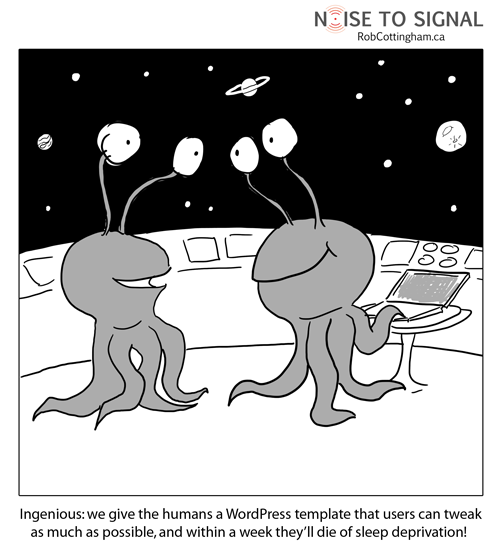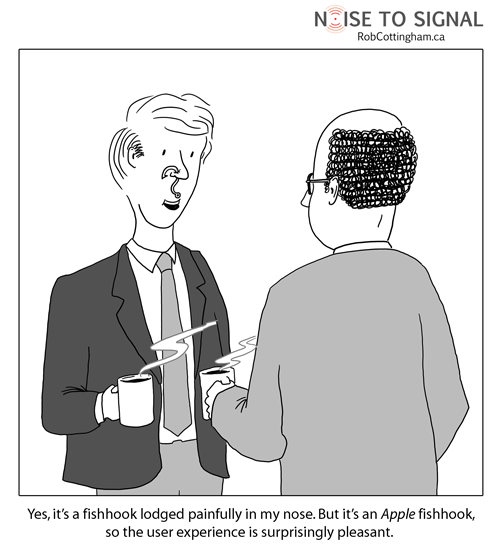 By Bernard Hickey
This piece is designed to be a lot like my Top 10 at 10, but it's all about snippets of news, analysis and comment around the topics of online publishing, marketing, advertising and technology trends, rather than financial issues. I welcome any comments or additions in the comments below, or email suggestions to me at bernard.hickey@interest.co.nz
It's worth starting with a WordPress joke, courtesy of the always excellent Noise to Signal from Rob Cottingham.
By Bernard Hickey
This piece is designed to be a lot like my Top 10 at 10, but it's all about snippets of news, analysis and comment around the topics of online publishing, marketing, advertising and technology trends, rather than financial issues. I welcome any comments or additions in the comments below, or email suggestions to me at bernard.hickey@interest.co.nz
It's worth starting with a WordPress joke, courtesy of the always excellent Noise to Signal from Rob Cottingham.
 1. Entrepreneurial journalism - Jeff Jarvis talks at BuzzMachine about the idea of entrepreneurial journalism a lot and it's a concept I like. We're doing a version of it here. Here's a wiki on the subject with a bunch of links. Jarvis believes big traditional media will be replaced by a flowering of entrepreneurial journalists working for themselves in loose networks funded by various advertising networks, including Google adsense. I wonder how many journalism schools are thinking about or teaching entrepreneurial journalism in New Zealand.
Jeff also points to this memorable signoff speech last week by Greg Hadfield, the Telegraph's Head of Digital Development, who told questioners at an industry conference that newspapers had no future and he was leaving. I agree with this. Having worked inside a newspaper group, I just don't think they can ever 'get it'. That's partly why I left and why I think journalists in New Zealand need to take a few more risks and go out on their own. The infrastructure costs are so low and the freedom is so high that opportunities are there for the taking. Hadfield was a former news editor at The Times of London.
1. Entrepreneurial journalism - Jeff Jarvis talks at BuzzMachine about the idea of entrepreneurial journalism a lot and it's a concept I like. We're doing a version of it here. Here's a wiki on the subject with a bunch of links. Jarvis believes big traditional media will be replaced by a flowering of entrepreneurial journalists working for themselves in loose networks funded by various advertising networks, including Google adsense. I wonder how many journalism schools are thinking about or teaching entrepreneurial journalism in New Zealand.
Jeff also points to this memorable signoff speech last week by Greg Hadfield, the Telegraph's Head of Digital Development, who told questioners at an industry conference that newspapers had no future and he was leaving. I agree with this. Having worked inside a newspaper group, I just don't think they can ever 'get it'. That's partly why I left and why I think journalists in New Zealand need to take a few more risks and go out on their own. The infrastructure costs are so low and the freedom is so high that opportunities are there for the taking. Hadfield was a former news editor at The Times of London.
He (Hadfield) urged people to be more entrepreneurial: "The future is much more diverse. There's not a dichotomy between being a journalist and an entrepreneur - the future is the individual journalist, not big media. "The challenge is for big, monolithic media to recognise that being entrepreneurial is corporate ethos, to reflect in the structure to leverage the skills of the individual within the organisation."2. Go Google - Last week Google stopped censoring search results in China and said it was considering pulling out after unnamed groups in China tried to hack into Google (and other's) systems to get information from dissidents in China. Finally Google has grown a pair and started living up to its 'Don't be evil' motto. There's been a mountain of commentary, but this one from Ethan Zuckerman is the best I've seen. He suggests one reason Google may have done this is to prepare to build a system to help those fighting internet censorship. I listened to Chinese blogger Isaac Mao when he came to New Zealand last year and was inspired by his tales of how 20 million bloggers use all sorts of techniques to get around the great firewall. Just imagine if Google could put all their server power to help the likes of Isaac defeat the Great Firewall? Now that would be truly not evil. 3. Paywall debate - The great debate about great Paywall's for news just won't go away. Journalism Online has been talking about a solution to the problem newspapers have for a while. Now it is saying the solution is an FT.com style metred system where the first 10-15 articles a month are free, before a fee kicks in after that. That seems more realistic than the usual pay or go away demand. Here Journalism Online's Steve Brill talks on minonline about his latest thinking before trials kick off. Many newspapers, including those in this part of the world, are pinning their hopes on Brill's machine coming up with a solution.
Brill says that more than 1,300 publishers have partnered with the company, and the first tests of the paid content network will start in coming weeks. In almost all cases, publishers will start by giving visitors access to 10 or 15 articles for free before asking them to pay. The idea is that frequent visitors to a site are demonstrating they value a brand's content and are the ones most likely to pay a fee for unfettered use of the site. When Journalism Online first announced its plans to help publishers charge for content many critics thought that sites were simply going to slam down a subscription wall, which would radically reduce traffic and ad revenues. "Everyone thought we were approaching the deep end of the swimming pool and that this guy was asking us to jump in without finding out how deep the water is," Brill says. "We are convincing people more accurately to think of this as the shallow end of the swimming pool with 32 steps where you walk in very comfortably."What's your view? Would you pay FT-style for a subscription to a site like ours where a certain number of articles were free before a fee kicked in? My view is it would severely limit our audience and change our model from being advertising driven. But I've been wrong before... 4. iPhone app? - Or maybe the monetisation model is to build an iPhone app which users seem prepared to pay for. Are there any New Zealand publishers thinking of building such an app? The Guardian says it sold 68,979 of the 2.39 pound apps in its first month.
Designed by an in-house team and built by 2ergo, the Guardian App for iPhone and iPod touch showcases news, comment, features, photo galleries and audio from guardian.co.uk through a range of features that can be personalised to each user. The app also enables the user to effortlessly browse the latest content most relevant to them, even offline.5. Pay perTweet? - Or maybe it's pay per tweet. The San Francisco Chronicle's Benny Evangelista reports on how actor-director LeVar Burton is making a 'four figure' income by selling sponsored tweets. I'm not so keen, although as long as it's clearly identified as an ad it might work.
Advertisers like Sony, NBC Universal and Microsoft have lined up for campaigns that pay Twitter users a few dollars to $10,000 per tweet, depending on their number of followers or their sphere of influence. "Twitter is the evolution of the Web page," said Sean Rad, the 23-year-old chief executive of Ad.ly Inc., a Beverly Hills company that has gained publicity by bringing advertisers to celebrity tweeters such as Burton, model-actress Kim Kardashian, who has 2.7 million followers, and rapper Soulja Boy Tell 'Em, who has 1.9 million followers.6. Here we go - New York Magazine is reporting that the New York Times, the world's most popular newspaper website, could be about to announce a metered paywall, similar to the one set up by the FT. The New York Times' previous attempt to charge customers for news and opinion, TimesSelect, failed.
New York Times Chairman Arthur Sulzberger Jr. appears close to announcing that the paper will begin charging for access to its website, according to people familiar with internal deliberations. After a year of sometimes fraught debate inside the paper, the choice for some time has been between a Wall Street Journal-type pay wall and the metered system adopted by the Financial Times, in which readers can sample a certain number of free articles before being asked to subscribe. The Times seems to have settled on the metered system.Jeff Jarvis is dismissive, saying it will drive away the New York Times' best customers online and make its journalism less relevant in an online world dominated by the 'link economy'.
So why would The Times charge? There are a few possible reasons: * It has failed at advertising, as I said of News Corp. recently. * Its costs are too high "” and rather than cutting them into a rational business, it desperately seeks some other revenue. * It is falling prey to PR, to the pressure of outsiders who keep nattering on about charging. * It has forgotten its own lessons with TimesSelect (and) sees amnesia as a strategy.The New Zealand Herald tried a TimesSelect type model and dumped it. The NBR is also trying a TimesSelect model where some stuff is free and some is put behind a bi-annual or annual subscription wall. The problem is it makes lowly paid columnists invisible online and few people want to pay for stuff that can get elsewhere. I'm sure New Zealand newspaper publishers will be watching the New York Times' moves closely, but my gut feel is this model will fail for anyone but the FT, which is able to charge readers something they can claim back from their employer. Felix Salmon at Reuters has some useful words of advice for the New York Times on how best to construct such a metered paywall, although he isn't enthusiastic and thinks the FT.com metered paywall is unfair.
The first and most important principle that the NYT must bear in mind is that any smart metering system will work more like a taxicab than like the dreadful FT approach: the key thing is that a meter measures how much of the service you've consumed, and then you pay for that much "” and no more. At the FT, by contrast, the meter slams down a hard paywall after you've reached n pageviews in a given month, and then charges you a very large sum for the n+1th pageview. That's stupid, because no single pageview is worth that much to a reader.8. Would you like free WiFi with that Happy Meal? - Here's a piece from Mashable about how Mcdonalds in the United States is about to roll out free WiFi in almost all its stores. Wouldn't it be nice if someone did something similar here? Why have our cafes and public places been so slow to offer free WiFi. 9. Spectacular photos - This is a great example from Boston.com of themed photo gallery that doesn't require multiple page impressions. 10. Couldn't resist a dig at the Apple Fan boys....I'm talking to you Lance...


We welcome your comments below. If you are not already registered, please register to comment
Remember we welcome robust, respectful and insightful debate. We don't welcome abusive or defamatory comments and will de-register those repeatedly making such comments. Our current comment policy is here.